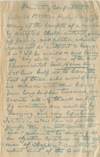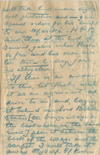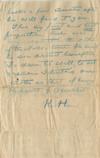Mahatma Letter to Pillai - LMW 2 No. 65
| Quick Facts | |
|---|---|
| People involved | |
| Written by: | Koot Hoomi |
| Received by: | R. Keshava Pillai |
| Sent via: | unknown |
| Dates | |
| Written on: | unknown |
| Received on: | 1882 |
| Other dates: | unknown |
| Places | |
| Sent from: | unknown |
| Received at: | Nellore |
| Via: | unknown |
This letter is Letter No. 66 in Letters from the Masters of the Wisdom, Second Series. Mahatma Koot Hoomi gives directions R. Keshava Pillai.[1]
< Prev letter in LMW 2
Next letter in LMW 2 >
Page 1 transcription, image, and notes
|
Would Brother Keshu Pillay get many of the benefits of a regularly accepted Chela, without giving up family and position, which he could not do without a heavy sin? If he would – and become my “lay chela,” one of the most favoured – let him serve me. Let him help us to have the best of those, who would have us deliver into their hands our long hidden treasures, our secrets all – and thank us but by insulting our names, by denying our very existence. For to say – “We have no positive proofs they are not spirits but men” amounts to denying us an objective existence in the opinion of skeptics? And that is what most of the Simla |
NOTES: |
Page 2
|
Theosophists are doing. To confound them would not require much. We have two chelas at Simla – but their vows prevent them from ever addressing a European before their final initiation. My offer is the following. “Deb” is called by me to Darjeeling, from whence I will send him to Simla with letters to Mr. Sinnett – the best of all. Would my Brother Keshu accompany and help him? The task is easy and there will not be much to do for either but be silent, and successfully play their parts. If the mission is accomplished, in return I will permit some of our secrets to be taught to Keshu. I |
NOTES:
|
Page 3
|
will take him under my special protection and give special orders for his benefit to our Upasika – H.P.B. –, and then at the end of several years when Keshu is free and his own master, then he may join us altogether. If there is an answer to this, let Keshu write it as an agreement, address to me, and, laying it behind our Lord Buddha’s statue (the bronze image on the book-case in the second room) place it between the back of the image and the carpet. I will take it away myself. If Keshu |
NOTES: |
Page 4
|
looks a few minutes after he will find it gone. This my first and LAST proposition. Keshu was very indiscreet in the matter of the Nellore letter. He must be more discreet hereafter. “To dare, to will, to act and remain silent” is our motto as that of every Kabalist and Occultist. Koot Hoomi. |
NOTES:
|
Context and background
Mr. Jinarajadasa provided this foreword to the Pillai letters:
THE recipient of the following letters was Mr. R. Keshava Pillai, an Inspector of Police stationed then at Nellore in Andhra Pradesh. The Founders visited Nellore in May, 1882, and a Branch was formed on the 8th, with Mr. Keshava Pillai as Secretary, and a well-to-do Hindu, an Assistant Collector, as President. After visiting other towns, the Founders returned to Nellore on the 24th. In the meantime, the English Collector or local representative of the British Government had brought pressure to bear on the President, and he had resigned as President – an incident referred to by Master K.H. in the first letter . Mr. Keshava Pillai was put on Probation by the Master, but proceeded no further. Later he lost interest in the T.S. and had a life of many worldly disappointments. Some years before his death, he gave Colonel Olcott the letters which he had received, and I transcribe from the originals at Adyar.
Received in Nellore in 1882.[5]
Physical description of letter
The original of this letter is preserved at the Theosophical Society, Adyar, Chennai, India.



